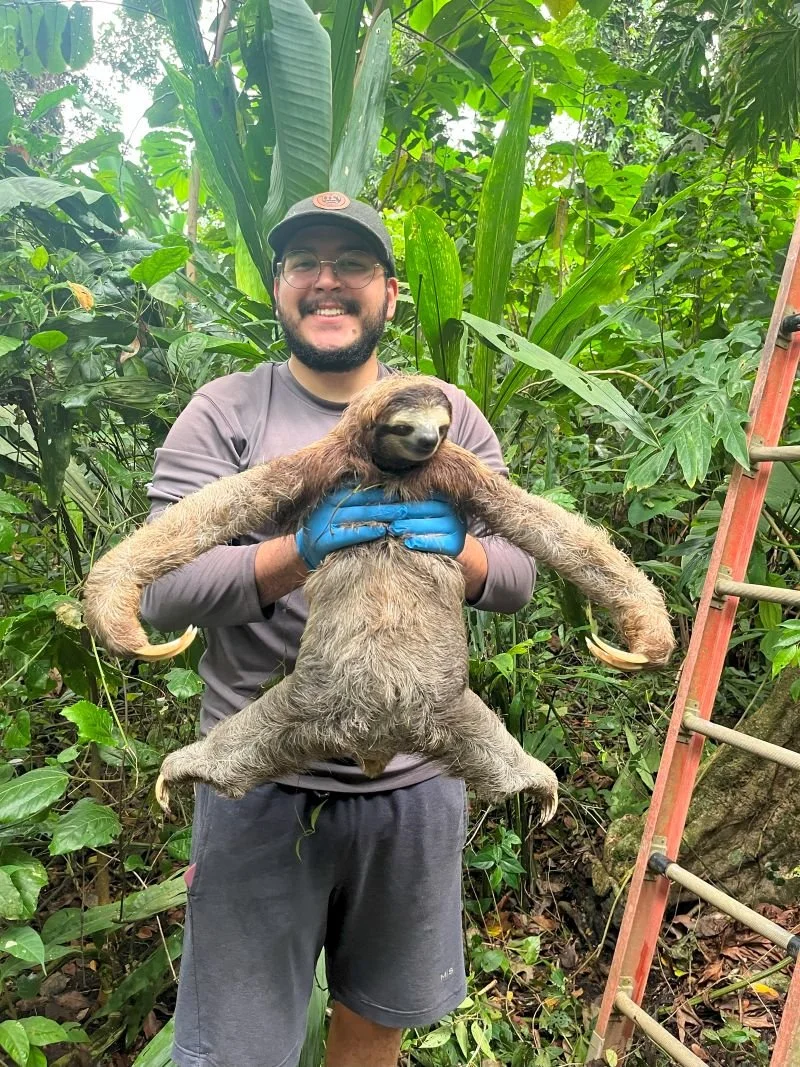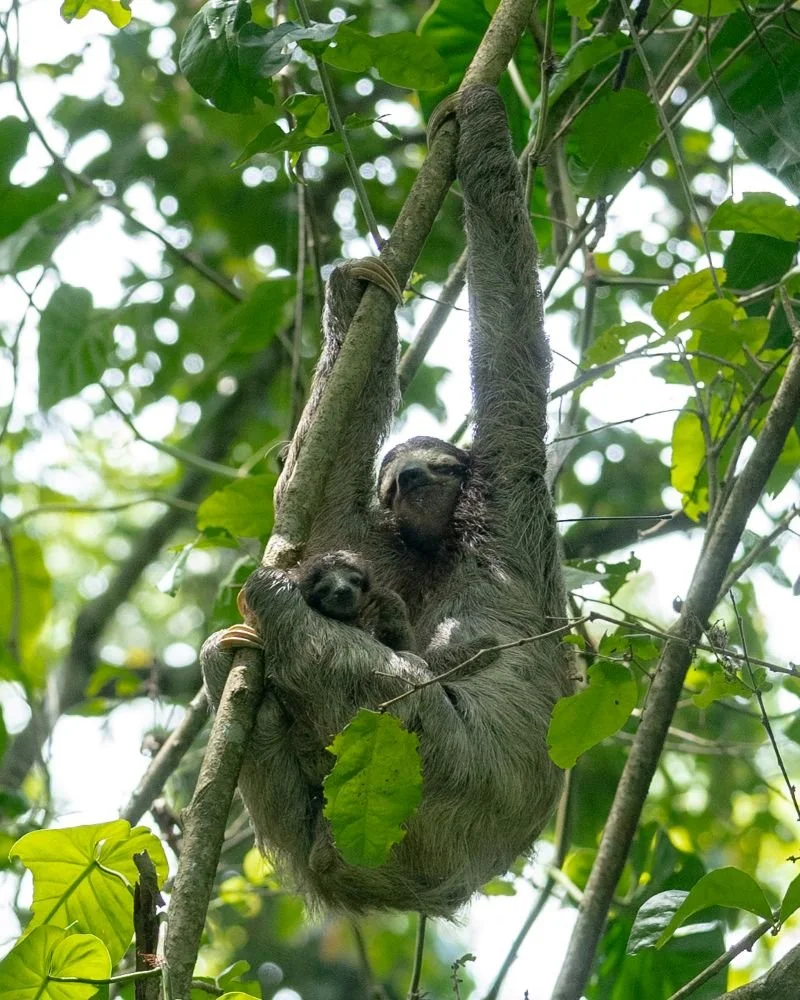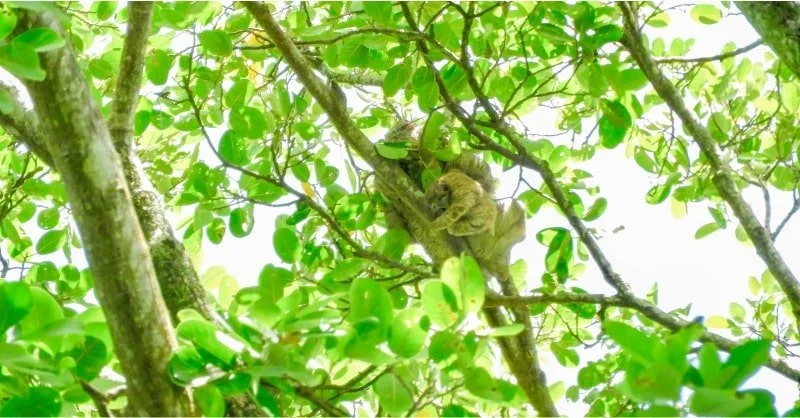Motherhood In The Treetops | May 2025
If you’re wondering what’s been happening with Luiza since we collared her at the start of 2022 and wrote her biography, we can sum it up in one word: Motherhood.
Since we began following Luiza’s journey, she has given birth to three babies: Pebble, Nugget, and the last one, Noodle.
What Luiza Is Teaching Us
Very little is known about reproduction and birth in three-fingered Bradypus sloths. The gestation period is estimated to be around 4 to 6 months (much shorter than the 11.5-month gestation period in two-fingered Choloepus species). This is because there has not been an officially recorded case of a Bradypus sloth becoming pregnant and giving birth in captivity, as their extremely fragile nature makes them incompatible with life in captivity.
Bradypus sloths spend between 5 and 6 months rearing their offspring (again, much shorter than their Choloepus relatives). Very little is known about Bradypus babies as biologists have only been able to observe them from afar in the wild. What little knowledge we do have is gleaned from rescue centers; however, the survival rate is very low. In fact, a statistician may describe the survival rates of baby Bradypus sloths in captivity as ‘negligible.’
Sloths like Luiza provide vital insight into the reproduction and rearing of Bradypus sloths. While it was first estimated that a female sloth will reproduce once every two years, Luiza has taught us that this may not be the case for Bradypus variegatus!
Expecting… or Just Full of Leaves?
Despite us getting a good look at Luiza while she was very heavily pregnant, it’s impossible to tell if a sloth is pregnant by sight or even physical examination. This is due to their large abdominal cavity and the fact that at any time they could be holding onto a week’s worth of poop - in fact a newborn Bradypus and their weekly bowel movement weigh around the same! As a result, small weight fluctuations are expected and cannot be used as an indication of pregnancy. The only reliable way to tell if a sloth is pregnant is via ultrasound.
So while we can’t confirm a pregnancy just by watching Luiza from the treetops, we’re learning to read her behavior, timing, and subtle patterns.
In this photo, Luiza is pregnant. Just a few weeks after, she gave birth to one of her babies!
Little Pebble Came Unexpectedly
Luiza’s first baby (to our knowledge), Pebble, was born on August 17th, 2022. We know the exact date because we had spotted her the day before, only 9 m high, so we were able to get a good look at her.
One of our favourite photos of Luiza and Pebble
It’s rare to see Luiza any lower than 15 meters, but sloths will often descend to the lower canopy just before giving birth. We didn’t make the connection at the time, until the next day, when the team reviewed a photo of Luiza (now back high in the trees) and, after zooming in, spotted a tiny baby!
From Mama’s Chest to Mischief in the Trees
Nugget, Luiza’s second baby, was a happy surprise born in September 2023, a little bit over a year since Pebble’s birth. Our tracking team regularly spotted Nugget gaining confidence and causing mischief, climbing all over Luiza and exploring nearby branches while Mama snoozed.
By February 2024, Nugget was off on their own, and Luiza shifted her territory to make room for a new, independent sloth in the coastal strip of forest.
Luiza and Nugget . Photo by Gabriel Ayala-Morales
A Clockwork Mom
Exactly one year after welcoming Nugget into the world, in October 2024, Luiza surprised us once again with baby number three: little Noodle.
She chose a rather dramatic spot to raise her newest baby, right near The Bluff, a stunning cliffside with panoramic ocean views. Beautiful, yes… but a nightmare for tracking. The terrain is steep and slippery, and keeping up with Luiza and Noodle meant navigating some very tricky ground.
Can you spot Noodle?
By April this year, Noodle had already gained her independence, and Luiza began leaving the cliffs behind.
Solitude… or something else?
These days, Luiza is keeping a low profile, nestled among the tall sangrillo trees along the Cocles beach trail, just south of where she raised her babies.
She’s not alone, though. We’ve spotted a few males hanging around the same area. Could it be coincidence? Or maybe something more?
We’re watching closely, hoping she’ll come low enough for us to change her tracking device. And we can’t help but wonder... could baby number four be on the way? If Luiza keeps up her impeccable timing, we might have some exciting news later this year. Place your bets!









